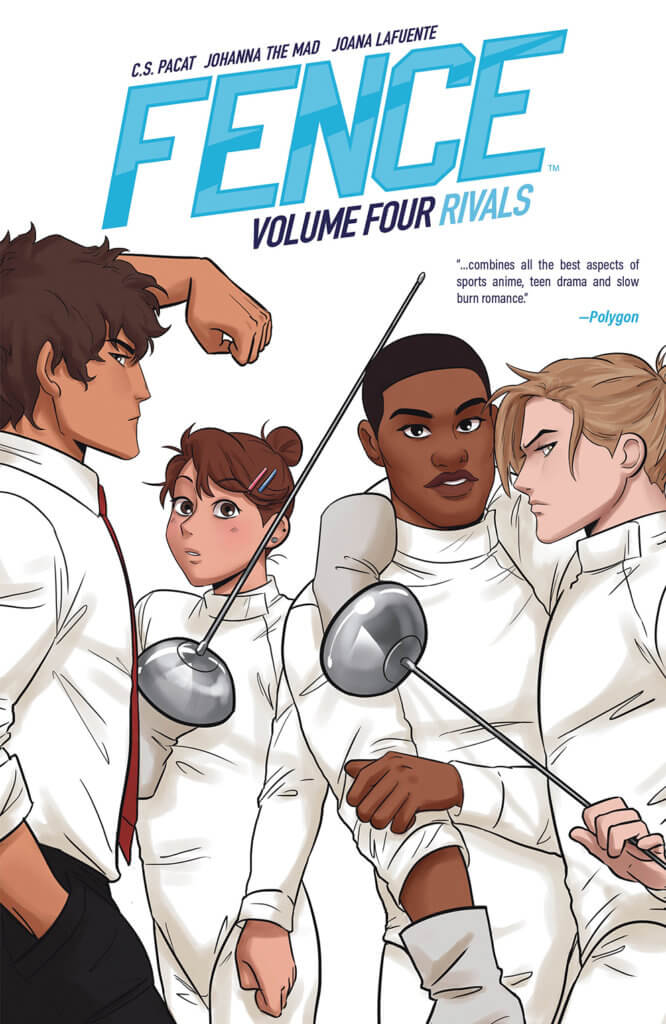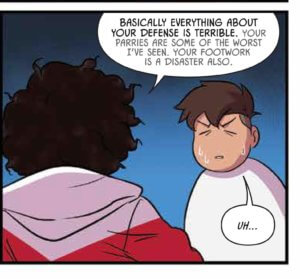The GLAAD-nominated series Fence! by C. S. Pacat and Johanna the Mad returns in graphic novel format as Fence: Rivals, collecting four chapters about King’s Row Academy’s practice match against the school that knocked them out of the State Championships last year. This new volume further develops the relationships that were set up earlier in the series and explores the world of fencing a bit more.
Except everything it says about fencing is wrong.
Fence: Rivals
C. S. Pacat (writer) Johanna the Mad (artist) Joana Lafuente (colors) Jim Campbell (letters)
BOOM! Studios
June 30, 2020 (print) July 15, 2020 (digital)
Okay, not everything, but there are a lot of inaccuracies both minor and major that drew my attention as a former high school fencer. Small details like the insignia on the socks being on the wrong side and the members of the team getting their names on jackets instead of school patches on the sleeves were distracting, but ultimately not a huge problem.
A bigger problem is the way practice at King’s Row is run. Nicholas is described to the audience as a complete beginner who lucked into being on the team because of his super amazing reflexes, and is told to focus on his bladework and accuracy. Any fencing coach will tell you this is not a smart move. Footwork and distance are the foundation of good fencing. All beginners start with advancing and retreating, just walking back and forth in a line until the correct posture is ingrained in their muscle memory. If Nicholas is terrible at everything, he needs to start with footwork. He shouldn’t even have a blade in his hand until he learns what distance means.

Media about sports, particularly uncommon sports, are often the audience’s first introduction to how that sport works. I know dozens of people who started playing volleyball or swimming or running because of sports anime. So when a series presents a sport in a realistic manner, the audience will take its depiction of that sport as a truthful portrayal. And emphasizing bladework over footwork without explaining the mechanics behind the French terminology this comic throws around or clearly depicting what it means is misleading.
Fence! tries to imitate sports manga by explaining fencing “rules” like how a team match works (I found the exact website Pacat used as a source for this because I’ve never heard a real person use those terms), but neither the author nor the artist seem to fully understand what they’re talking about, and it ends up feeling vague and unconvincing.

I was hoping that the switch to a graphic novel format would help with the pacing problems in the first twelve issues, but Pacat still hasn’t learned how to balance character development and actual fencing in a way that’s compelling. There is a lot of telling over showing when it comes to the fencing, such as in the panel above where the speech balloons tell us what fencing moves we’re supposed to be seeing. Comics are a visual medium. Show your readers what a “bind to quatre” or “ceding parry” even is.
Since Fence! is an LGBT-themed sports comic, it’s natural to draw comparisons to Check Please! by Ngozi Ukazu. Check Please! avoids having to explain the minutiae of hockey by focusing on the emotional reactions of the core cast to hockey. The sport is a huge part of everyone’s lives and the culture they exist in, but the readers never see a full hockey game because they don’t need to. The audience just needs to understand the character’s relationship with the sport. I feel like Fence! could have been more successful if it had focused more on developing the characters beyond their fencing and future romantic relationships, and used fencing more as a metaphor for their thoughts and emotions.
There is more character development in this volume than in previous issues. I really enjoyed the conversation Nicholas and Seiji had in their room at night, that was cute. Seiji learns the meaning of friendship and teamwork! Good for him! Harvard and Eugene get a little bit of depth too. Overall, the characters are still fairly two-dimensional, but slightly less so than they used to be.
I do find it jarring how most of the team and surrounding people are constantly depicted as a formless gray blob of a crowd, instead of gradually introducing other minor characters on the King’s Row team that might not be particularly relevant but are a consistent part of the background scenery. The backgrounds are so plain as to be almost abstracted, and the characters are depicted in an aggressively simplified cartoony style too often for it to be an effective comedic tool.
Fence! wants to be a character drama in which people fence, but it emphasizes the fencing too much to be that. It wants to be a sports manga about fencing, but the depictions of fencing are too vague and rushed to be that. The good parts are not enough to make up for the lack of research and uninspired art direction.

